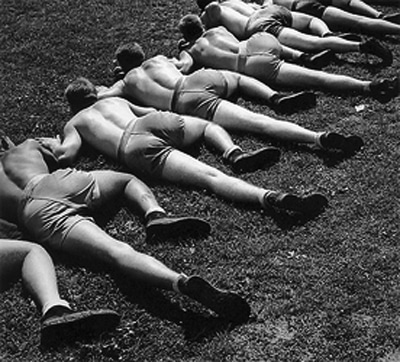
Editor’s note: This week we’re publishing excerpts from FM 21-20, an Army field manual from 1946 that includes the physical training program used by GIs during WWII. You can read the story behind FM 21-20 here. This series may offer you practical suggestions on exercises to incorporate into your own workouts, or simply inspire you to get in shape and embody the kind of strength and fitness that would make your grandpa proud!
Today we’re highlighting FM 21-20’s conditioning workout. While calisthenics have gone out of style for men, perhaps because of the association such exercises gained with the rise of lady-centric aerobics classes, they’re still a highly effective way of building cardiovascular and strength endurance. I actually first heard of FM 21-20 when I participated in a GoRuck Challenge; our merciless cadre utilized these very exercises for our “welcome party” — the two hour physical beatdown that kicks off the event. If you think doing this kind of workout is normally difficult, try it while wearing a 40 lb rucksack. Brutal!

FM 20-21: War Department Field Manual, 1946
Conditioning Exercises
EVALUATION OF CONDITIONING EXERCISES IN THE TOTAL CONDITIONING PROGRAM.
a. Conditioning exercises constitute the most extensively used activity in the Army physical training program. These selected exercises have a number of advantages: (1) they can be conducted anywhere; (2) they require no equipment; (3) they are readily adaptable to large groups; (4) they can be easily adapted to individual physiological differences; (5) they can be regulated for dosage and progression and; (6) if properly selected, they will reach and develop any desired muscle group in the body.
b. The chief disadvantage of conditioning exercises is that it is difficult to make them appealing to the men. This can be overcome by good leadership and the judicious use of supplementary activities.
ARRANGEMENT OF EXERCISES IN SET DRILLS.
a. A “set” drill is a carefully selected and arranged group of exercises which reach and develop all important muscle groups of the body. It is to be repeated many times. By repeating the same exercises over a long period of time, it is possible to achieve greater perfection and accuracy in execution. The use of a set drill eliminates the great waste of time associated with continually presenting and teaching new exercises. A set drill also provides the best method of securing progression in dosage.
b. From the vast number of conditioning exercises available, 2 sets of 12 exercises each have been chosen. The criteria for their selection were: first, they best reach the fundamental muscle groups of the body; secondly, they are easy to learn and to perform; and thirdly, they are simple to administer and supervise. The exercises which were selected have been carefully arranged in proper sequence for the best results. It is essential that each set be performed in the order prescribed.
c. Since two of the exercises in each set are done from the supine position, appropriate exercises have been included as substitutes where ground conditions make it inadvisable for the men to lie down. Other substitutions are not recommended. If additional exercises are desired, they should be added to those comprising these basic sets — not substituted for them.
USE OF DIFFERENT DRILLS.
a. Two set drills have been selected to provide variation in the program. The two drills are considered of equal value and difficulty. An organization may adopt one set and never use the other. If both sets are used, they should not be alternated from day to day, but rather one set should be used exclusively for several months before the other is introduced. Since each exercise in a set bears a relation to each other exercise in the same set, the exercises of the two sets must not be interchanged.
b. If further variety is desired it may be introduced by substituting rifle, or log exercises, or the strength course for the conditioning exercises, since they reach and develop approximately the same muscle groups. However; here again, substitutions must be by entire sets and not by individual exercises.
NECESSITY FOR PRECISION AND ACCURACY. Constant insistence upon the proper execution of each exercise is imperative since conditioning exercises lose much of their value unless performed exactly as prescribed. Considerable time and effort must be expended during the early stages to teach the exercises properly to all men. Just as much patience and time are required to obtain perfection in executing the conditioning exercises as is required to attain the same degree of skill in executing the manual of arms.
CONDUCTING CONDITIONING EXERCISES.
a. The conditioning drill is to be done in a continuous fashion. Each exercise has been given a name. The instructor requires all men to memorize the exercises so that the conduct of the program may be facilitated. After having performed the exercises several times, the men are usually able to complete the entire set with only enough pause between exercises for the instructor to indicate the next exercise by name. This continuous method of conducting conditioning exercises greatly intensifies the work load and conserves time.
b. After the men know how to execute the exercises properly, conditioning exercises are always given in cadence. This is counted either by the instructor, by one of his assistants or by the entire group. The cadence for the different exercises varies. Where possible, these exercises should be done to the accompaniment of music.
c. Certain exercises such as push ups, squat jumps, or rowing exercises may be executed at will on occasions. The men respond well to performing these exercises in this manner. The instructor merely indicates the number of repetitions which are to be done and as soon as the men have completed this number they stand at ease.
WARM UP DRILL
USE OF WARM UP DRILL.
a. Warm up exercises are necessary when physical training activities are strenuous or are conducted in cool or cold weather. In general it is desirable to warm up unless vigorous activities are participated in just before the physical training period.
b. Wherever practicable troops should be warmed up by double timing to the exercise area. Where this is not feasible the following exercises may be used to begin the day’s program. The purpose of this drill is to warm up the muscles. There should be no more repetitions than are necessary to accomplish this purpose.
EXERCISE 1: STORK WALK

Starting Position. Attention.
Cadence. Slow to moderate.
Movement:
(1) Raise left knee until upper leg is perpendicular to body. At same time raise right arm forward to shoulder height. Lower left leg and right arm to starting position.
(2) Repeat count (1) with right foot and left arm.
(3) Repeat count (1).
(4) Repeat count (2).
Four to six (four count) repetitions. This is a slow; powerful stationary walk. Swing the arms in a larger and larger movement until they are almost vertical on the upswing and downward and behind the hips on the downswing.
EXERCISE 2: BACKFIELD CROUCH
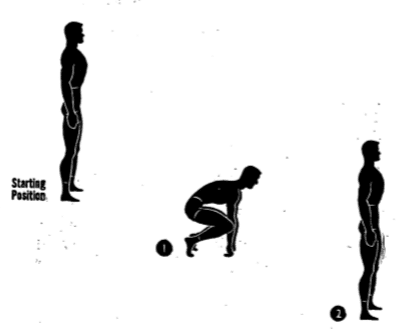
Starting Position. Feet apart about eighteen inches. Otherwise, at attention.
Cadence. Moderate.
Movement:
(1) Squat and touch the fingers to the ground 12 to 18 inches in front of the feet. Knees are bent, back is straight, and head is up.
(2) Recover to starting position.
(3) Repeat count (1).
(4) Recover to starting position. Two to four (four count) repetitions.
EXERCISE 3: STATIONARY RUN
Continue this exercise only long enough to obtain a feeling of flexibility and warmth in the muscles, usually from 20 to 40 steps. The cadence is moderate.
EXERCISE 4: THE BOBBER
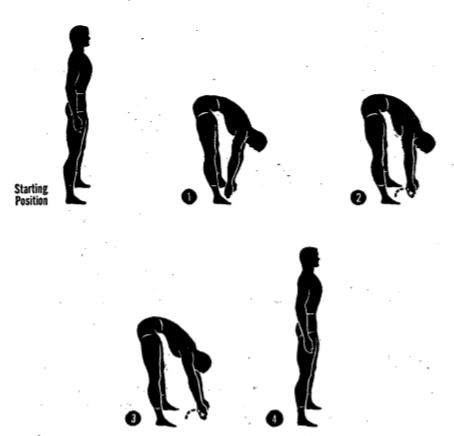
Starting Position. Side straddle, arms at side.
Cadence. Slow to moderate.
Movement:
(1) Bend forward with knees straight and reach hands to the ground between feet.
(2) Relax slightly, then “bounce” downward again, reaching about 6 inches farther forward.
(3) Again, relax and “bounce” downward, reaching forward about a foot or more.
(4) Recover to starting. position.
Four to six (four count) repetitions. In executing this exercise, go down to, but not beyond the point of straining. The flexion should be greater with each succeeding repetition until the muscles of the back and the ,backs of the legs have been stretched and limbered up.
CONDITIONING EXERCISE DRILLS
DRILL NO. 1.
a. Five repetitions of each exercise, whether it be a four or eight count exercise, constitute the starting dosage. As the strength and endurance of the soldier increases, the number of repetitions is increased one each week until a maximum of 16 has been reached.
b. Ground conditions may make some of the exercises, below impracticable. Substitute exercises have been provided. These are distinguished from the regular exercises by the addition of an “A”.
EXERCISE 1: HIGH JUMPER
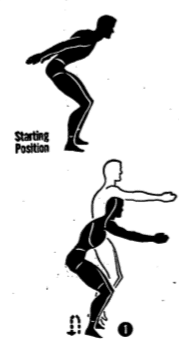

Starting Position. Feet separated about 12 inches, knees slightly bent, body bent forward 45° at the waist, arms raised backward.
Cadence. Moderate.
Movement:
(1) Swing arms forward and jump upward a few inches.
(2) Swing arms backward and jump upward a few inches.
(3) Swing arms forward and overhead vigorously and jump upward at least 12 inches.
(4) Jump upward several inches and swing arms backward.
These movements of EXERCISE 1, the HIGH JUMPER are continuous and work into one another. The arm swing is much like that performed just prior to a standing broad jump. The jumps on counts (1), (2), and (4) are merely “crow hops”. The jump on count (3) calls for full effort.
EXERCISE 2: BEND AND REACH
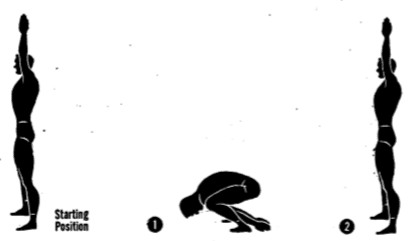
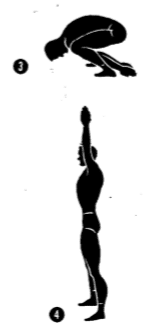
Starting Position. Side straddle, arms overhead.
Cadence. Moderate.
Movement:
(1) Bend trunk forward and downward. At the same time swing arms between the legs, touching fingers to ground between and behind the heels. Knees are bent. Touch fingers as far behind heels as possible.
(2) Recover to starting position.
(3) Repeat count (1).
(4) Recover to starting position.
EXERCISE 3: SQUAT THRUST
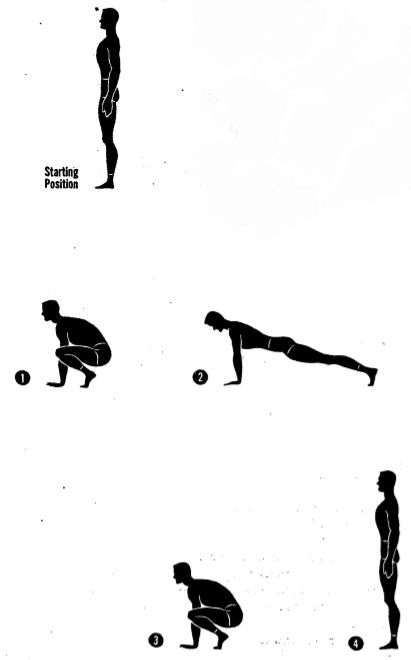
Starting Position. Attention.
Cadence. Moderate.
Movement:
(1) Bend at knees and hips and, squatting down, place hands on the ground shoulder width apart. Keep elbows inside the knees.
(2) Thrust feet and legs backward to a front leaning rest position. Keep body straight from head to heels. Support weight on hands and toes.
(3) Recover to the squatting position.
(4) Recover to starting position.
EXERCISE 4: ROWING EXERCISE
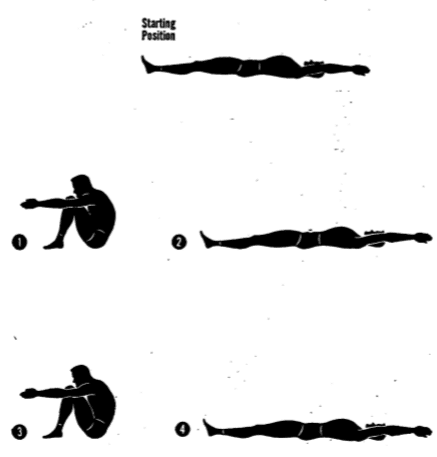
Starting Position. On back, arms extended overhead, feet together.
Cadence. Slow to moderate.
Movement:
(1) Sit up and at the same time bend knees sharply. Lean forward, swinging arms forward to a “rowing position”. Keep knees together and against the chest, feet flat on the ground, and heels close to buttocks.
(2) Recover to starting position.
(3) Repeat count (1).
(4) Recover to starting position.
EXERCISE 4A: BOTTOMS UP
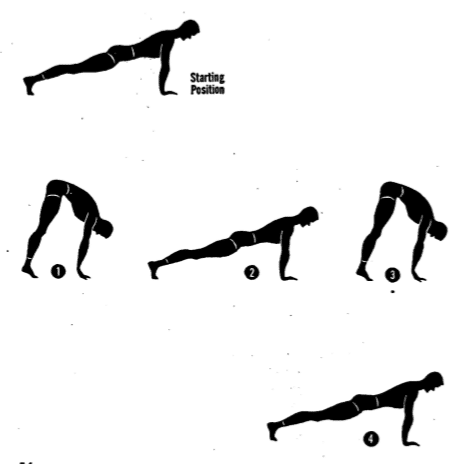
Starting Position. Front leaning rest, body straight from head to heels, weight supported on hands and toes.
Cadence. Moderate.
Movement:
(1) Push against ground with feet, keeping knees straight, raise hips sharply and jump, feet forward so that hips are elevated and trunk and legs form an inverted V. Jump as far forward as possible with knees straight.
(2) Recover to starting position.
(3) Repeat count (1).
(4) Recover to starting position.
EXERCISE 5: SQUAT BENDER

Starting Position. Standing with feet slightly separated, hands on hips.
Cadence. Moderate.
Movement:
(1) Do a full knee bend, and thrust arms forward. Keep fingers extended, palms down, and trunk erect.
(2) Recover to starting position.
(3) Bend trunk forward, keeping knees straight, touch ground in front of toes.
(4) Recover to starting position.
EXERCISE 6: PUSH UP
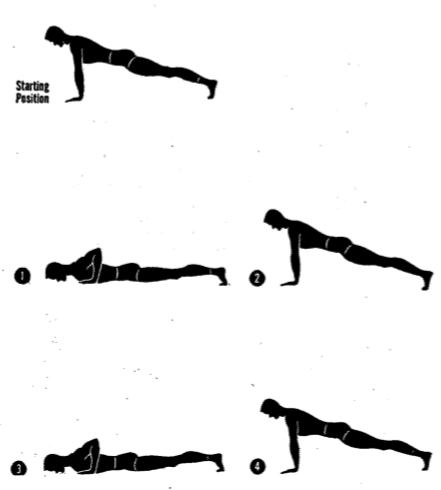
Starting Position. Front leaning rest, body straight from head to heels, weight supported on hands and toes.
Cadence. Moderate or at will.
Movement:
(1) Bend elbows and touch chest to ground keeping body straight.
(2) Straighten elbows, and recover to starting position.
(3) Repeat count (1).
(4) Repeat count (2).
EXERCISE 7: SIDE BENDER

Starting Position. Side straddle, arms overhead, thumbs interlocked.
Cadence. Slow.
Movement:
(1) Bend sidewards sharply to the left, bending the left knee. Bend straight to the side without twisting the trunk or shoulders.
(2) Recover slightly and repeat with a bounce.
(3) Repeat count (2).
(4) Recover to starting position.
Repeat on right side for counts (5), (6), (7), and (8).
EXERCISE 8: BODY TWIST

Starting Position. On back, arms on ground and extended sideward, palms down, legs vertical, feet together, knees straight.
Cadence. Slow.
Movement:
(1) Lower legs to the left, twisting trunk and touching ground next to left hand. Keep knees straight, and both shoulders on ground. Legs must be lowered not dropped.
(2) Recover to starting position without bending knees.
(3) Lower legs to right, twisting trunk, and touching ground near right hand.
(4) Recover to starting position.
EXERCISE 8A: TURN AND BOUNCE

Starting Position. Side straddle, arms sideward, palms up.
Cadence. Moderate.
Movement:
(1) Turn trunk sharply to left to limit of motion, then relax rotation slightly.
(2) Bounce to the left, and relax slightly.
(3) Repeat count (2).
(4) Recover to starting position. Repeat on right side of counts (5), (6), (7), and (8).
EXERCISE 9: SQUAT JUMPER

Starting Position. Full knee bend with feet separated about 8 inches and left foot forward about 8 inches, fingers laced on top of head.
Cadence. Moderate or at will.
Movement:
(1) Spring upward straightening the knees and causing both feet to leave the ground. Reverse the position of the feet while in the air, moving the right foot forward and the left foot backward. Return to starting position.
(2) Repeat count (1) without pause.
(3) Repeat count (1) without pause.
(4) Repeat count (1) without pause.
*Execute only half the number of four count repetitions used for other exercises.
EXERCISE 10: TRUNK TWISTER
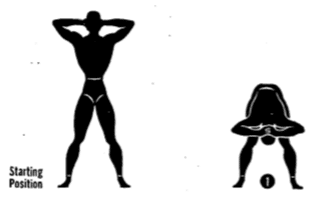

Starting Position. Side straddle, fingers laced behind head, elbows backward, chin in.
Cadence. Slow.
Movement:
(1) Keeping knees straight, bend forward sharply, with a slight bouncing movement that causes slight recovery from the bend. This is a vigorous movement.
(2) Bounce downward, and simultaneously turn the trunk sharply to the left so that the right elbow swings downward between the knees.
(3) Repeat count (2) to the right. This time the left elbow swings down between knees.
(4) Recover to starting position, pulling head backward and chin inward strongly.
EXERCISE 11: STATIONARY RUN

Starting Position. Standing with arms in loose thrust position.
Cadence. First slow, then fast, then slow.
Movement:
Begin run slowly, then speed up somewhat, raising knees above hips. Increase gradually to full speed, raising knees hard, then slow down. For men in good condition, this exercise should continue for approximately 1 to 1.5 minutes, the middle half minute of which should be at top speed.
EXERCISE 12: EIGHT COUNT PUSH UP
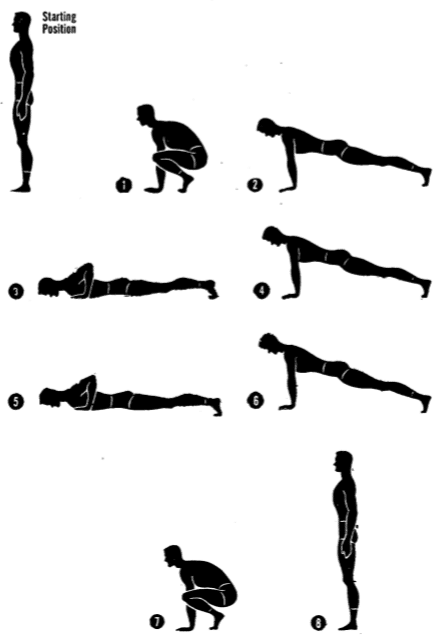
Starting Position. Attention.
Cadence. Moderate.
Movement:
(1) Bend at knees and hips and place hands on floor in front of feet in squatting position.
(2) Thrust feet and legs backward to a front leaning rest position. Keep body straight from head to heels. Support weight on hands and toes.
(3) Bend elbows and touch chest to ground.
(4) Recover to front leaning rest position.
(5) Repeat count (3).
(6) Recover to front leaning rest position.
(7) Recover to squatting position.
(8) Recover to starting position.
DRILL NO. 2.
EXERCISE 1: JUMPING JACK
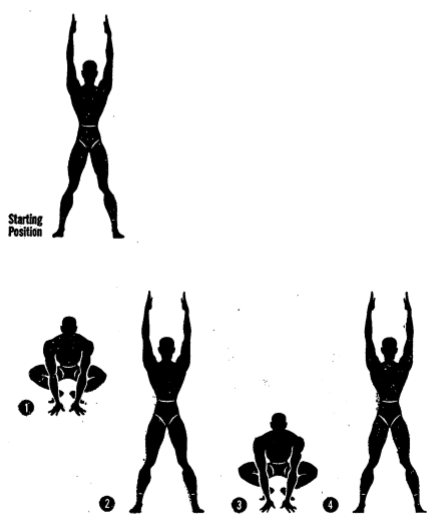
Starting Position. Side straddle, arms overhead.
Cadence. Fast.
Movement:
(1) Jump to position with feet together and squat to full knee bend position, swinging arms sideward and downward. Place hands on ground in front of feet.
(2) Recover to starting position by jumping to side straddle and swinging arms sideward over head.
(3) Repeat count (1).
(4) Recover to starting position.
EXERCISE 2: LUNGER
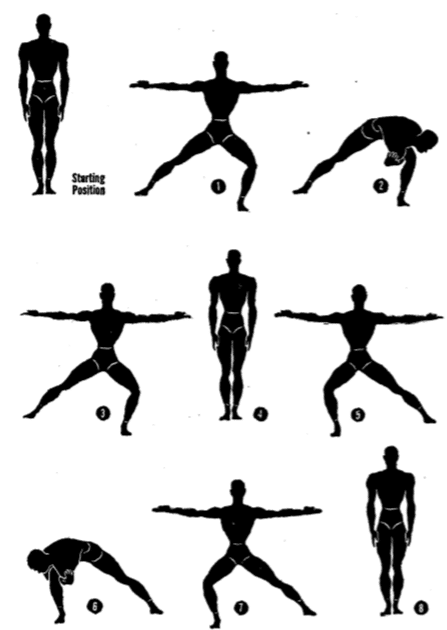
Starting Position. Attention.
Cadence. Moderate.
Movement:
(1) Lunge diagonally forward left, with arms sideward, and palms up.
(2) Bend sharply forward and downward and wrap arms around left thigh above knee, “folding” arms around thigh.
(3) Recover to first position.
(4) Recover to starting position. Repeat on right side for counts (5), (6), (7) and (8).
EXERCISE 3: DIAGONAL SQUAT THRUST

Starting Position. Attention.
Cadence. Moderate.
Movement:
(1) Squat, placing hands on ground shoulder width apart. Keep elbows inside knees.
(2) Thrust feet and legs diagonally backward to the left to a front leaning rest position. Keep body straight from head to heels, but at a 45° angle from the hands.
(3) Recover to the squatting position.
(4) Recover to starting position.
Repeat thrusting legs diagonally backward to the right. Perform half the repetitions to the left and half to the right. Alternate sides.
EXERCISE 4: V-UP

Starting Position. On back, arms on ground 45° from the sides, palms down.
Cadence. Moderate.
Movement:
(1) Raise legs with knees straight, and at the same time sit up until trunk and legs form a V position. Then relax slightly. (This is a “bounce” movement.)
(2) Again pull vigorously to the V position, and again relax.
(3) Repeat count (2).
(4) Recover to starting position.
EXERCISE 4A: BACK BENDER
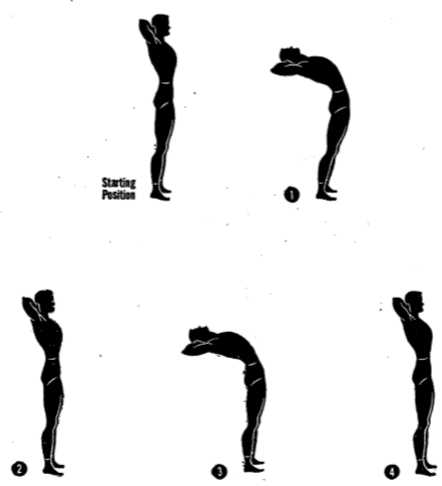
Starting Position. Standing, feet twelve inches apart, fingers laced behind head.
Cadence. Slow.
Movement:
(1) Bend upper trunk backward, raising chest high, pulling elbows back, and looking upward. Keep knees straight.
(2) Recover to starting position.
(3) Repeat count (1).
(4) Recover to starting position.
EXERCISE 5: SQUAT STRETCH

Starting Position. Attention.
Cadence. Moderate.
Movement:
(1) Squat down with hands on ground about 1 foot in front of feet.
(2) Keeping hands on ground, straighten knees completely and raise hips.
(3) Recover to first position.
(4) Recover to starting position.
EXERCISE 6: ONE LEGGED PUSH UP
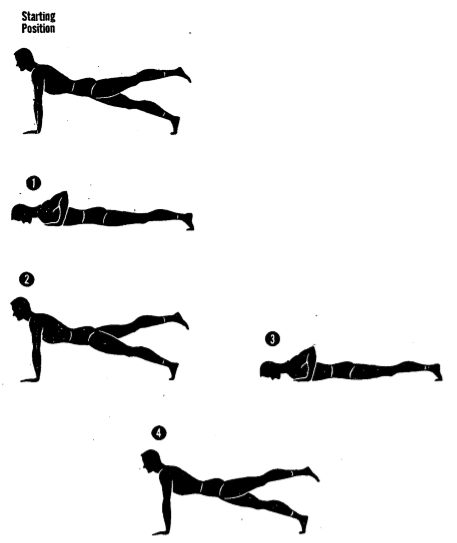
Starting Position. Front leaning rest, with left leg raised backward, knee straight and foot about 2 feet above ground.
Cadence. Moderate or at will.
Movement:
(1) Bend elbows and touch chest to ground, keeping the body straight. At the same time lower left foot to ground.
(2) Straighten elbows and push up to straight arm position. At the same time raise right leg.
(3) Bend elbows and touch chest to ground, lowering right foot to the ground.
(4) Recover to starting position.
EXERCISE 7: LUNGE AND BEND

Starting Position. Attention.
Cadence. Moderate.
Movement:
(1) Lunge sideward left and swing arms sideward and upward.
(2) Bend trunk sideward keeping arms parallel.
(3) Recover to first position.
(4) Recover to starting position. Repeat on right side for counts (5), (6) , (7), and (8).
EXERCISE 8: LEG CIRCLER
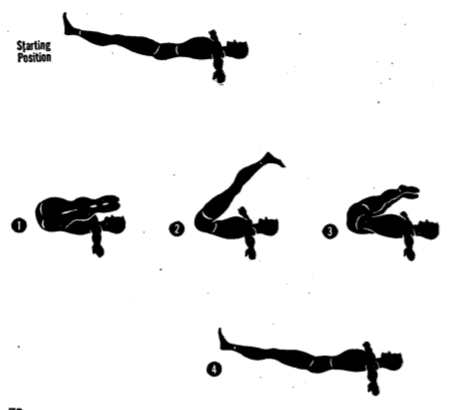
Starting Position. On back, arms stretched sideward, palms down, feet raised about 1 foot from ground, knees straight.
Cadence. Slow.
Movement:
(1) Swing legs as far as possible to the left, keeping knees straight and legs together.
(2) Swing legs in front of chest flexing thighs as close as possible in front of trunk.
(3) Swing legs as far as possible to the right.
(4) Recover to starting position.
After having completed half the number of repetitions, the direction of the leg circles should be reversed. The cadence should be counted so that a continuous circling movement of the legs is made.
EXERCISE 8A: ARCH THRUST
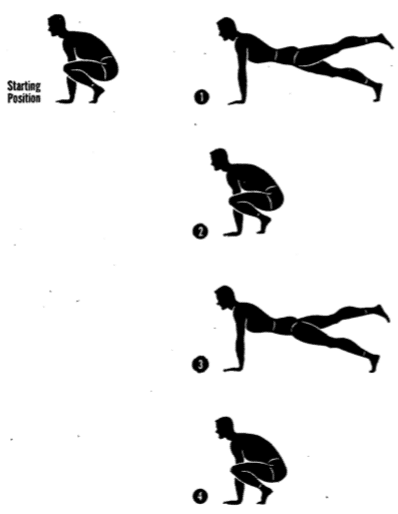
Starting Position. Squatting position, hands on ground in front of feet.
Cadence. Slow.
Movement:
(1) Thrust both legs backward, coming to rest with the right foot on ground and the left leg raised backward with knee straight. Hips should not be elevated. Head should be raised facing forward.
(2) Recover to starting position.
(3) Repeat count (1) raising right leg.
(4) Recover to starting position.
EXERCISE 9: DOUBLE HIGH JUMPER
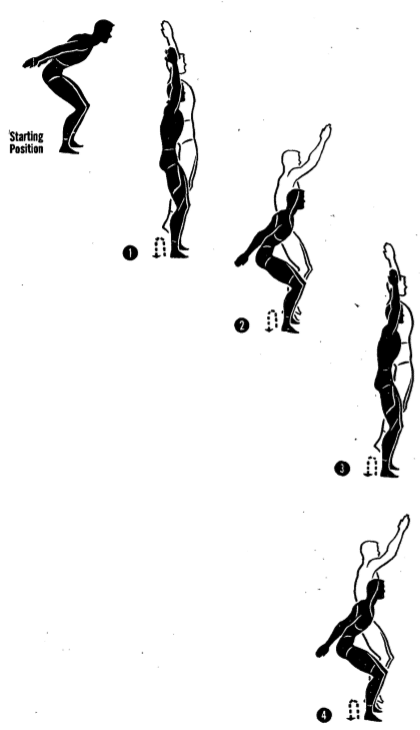
Starting Position. Feet separated about 12 inches, knees slightly bent, arms raised backward, body bent slightly forward at the waist.
Cadence. Moderate.
Movement:
(1) Swing arms forward and upward and jump upward vigorously.
(2) Swing arms downward and backward and jump upward slightly.
(3) Repeat count (1).
(4) Repeat count (2).
EXERCISE 10: TURN AND BEND
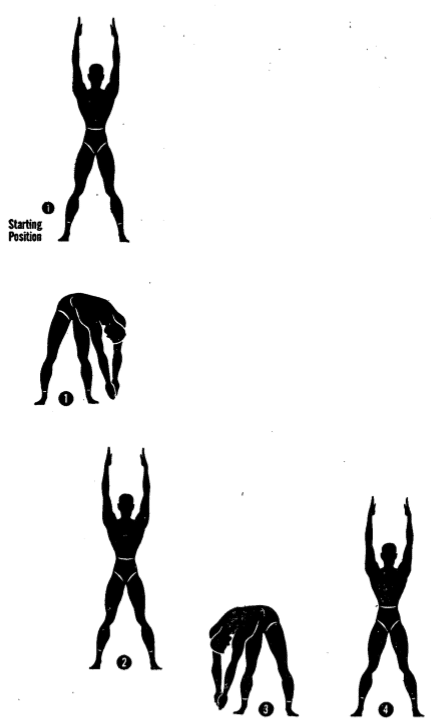
Starting Position. Side straddle, arms overhead.
Cadence. Moderate.
Movement:
(1) Turn trunk to left and bend forward over left thigh, attempting to touch hands to ground outside of left foot. Keep the left knee straight. On successive repetitions attempt to touch farther and farther to the side.
(2) Recover to starting position. Chest should be high, and arms should reach upward hard.
(3) Turn trunk to right and bend forward over right thigh, attempting to touch hands to ground outside right foot. Keep right knee straight.
(4) Recover to starting position.
EXERCISE 11: STATIONARY RUN
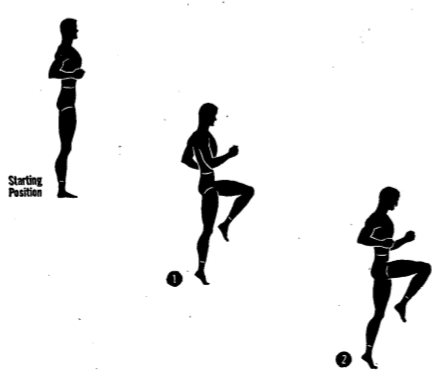
Starting Position. Standing with arms in loose thrust position.
Cadence. First slow, then fast, then slow.
Movement:
Begin run slowly, then speed up somewhat, raising knees above hips. Increase gradually to full speed, raising knees hard, then slow down. For men in good condition, this exercise should continue for approximately 1 to 1.5 minutes, the middle half minute of which should be at top speed.
EXERCISE 12: LEG THRUST AND DIP
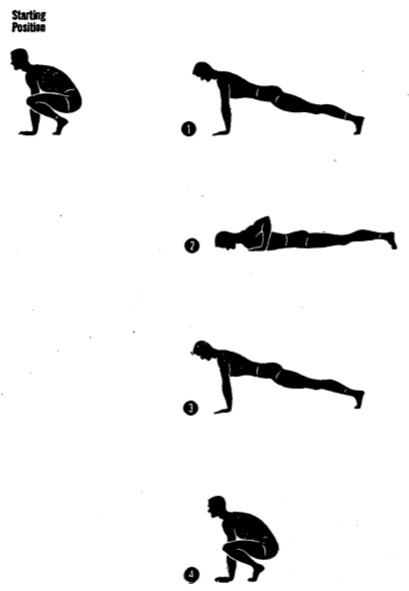
Starting Position. Squatting position.
Cadence. Moderate.
Movement:
(1) Thrust legs backward to front leaning rest.
(2) Bend elbows and touch chest to ground keeping body straight.
(3) Straighten elbows, raising body in a straight line.
(4) Recover to starting position.
Read the Entire Series
The Importance of Physical Fitness
Tags: Exercises



